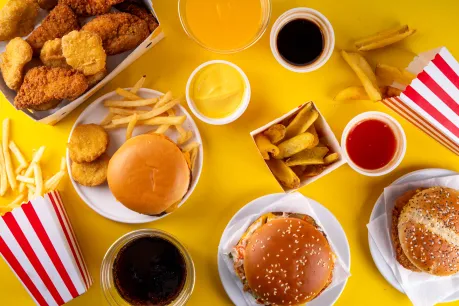McDonald’s E. coli Outbreak Lawsuit – What to Know

Injured?
An E. coli outbreak has been traced back to McDonald’s—and consumers are not lovin’ it.
According to the Centers for Disease Control and Prevention (CDC), dozens of people across the U.S. have contracted E. coli traced to ingredients in McDonald's Quarter Pounders.
So far, 49 people from 10 states have been infected by E. coli O157:H7, which causes a severe intestinal infection in humans. Ten people have been hospitalized, including a child, and one older person in Colorado has died.
If you or someone you love has been affected by the McDonald’s E. coli outbreak, contact Morgan & Morgan today. We take corporate negligence very seriously and help victims to fight for justice. For over 35 years, we have fought For the People—not the powerful—and have recovered over $30 billion for our clients in the process.
One of the largest fast food chains in the world should not take the health and safety of its customers lightly, and allowing tainted food to be served to unsuspecting consumers is unacceptable. Reach out today for a free case evaluation to learn more about your legal options.
How Did the McDonald’s E. coli Outbreak Start?
According to the CDC, every patient sick with E. coli said that they ate at McDonald's before falling ill, and most said they ate the McDonald’s Quarter Pounder hamburgers, specifically.
While the exact ingredients that caused the outbreak are still undetermined and under investigation, the CDC is focused on two possible culprits: fresh, sliced onions and fresh beef patties.
What Is McDonald’s Doing to Fix This?
McDonald's told the CDC it has removed onions and beef patties used for Quarter Pounder hamburgers from stores in the states where cases have been reported.
McDonald's North America Chief Supply Chain Officer Cesar Piña said that the fast food chain believes the outbreak is linked to onions "used in the Quarter Pounder and sourced by a single supplier that serves three distribution centers."
What Are the Symptoms of E. coli Poisoning?
Certain strains of E. coli bacteria can make people sick and can sometimes even be fatal.
E. coli symptoms often begin three to four days after ingesting the bacteria and include severe stomach cramps, diarrhea, bloody stools, and vomiting.
Some people recover on their own within five to seven days, but some people may develop HUS and require hospitalization.
Who Is Liable for the McDonald’s E. coli Outbreak?
Liability in food poisoning cases like an E. coli outbreak can fall on several parties within the supply chain. Each of these entities has a legal duty to ensure that the food they handle is safe for consumption. Here's a breakdown of potential liable parties:
McDonald’s Corporation
McDonald’s, as the company serving the food, is typically the first entity people associate with the outbreak. As a fast-food giant, they have a responsibility to ensure that the food served in their restaurants is safe to eat. This includes:
- Proper food handling practices in each location.
- Adequate training for employees on safe food preparation.
- Ensuring suppliers meet rigorous safety standards.
If McDonald’s failed to meet any of these responsibilities, they could be held liable for the resulting illnesses. Victims may be able to file lawsuits against McDonald’s for negligence if it can be proven that a lapse in food safety protocols led to the outbreak.
Suppliers of Contaminated Ingredients
McDonald’s sources its ingredients from a variety of suppliers, including farms, meat processors, and vegetable growers. If the E. coli outbreak is traced back to a contaminated ingredient provided by a supplier, that supplier could also be held liable. Common sources of E. coli include:
- Beef suppliers: If undercooked hamburgers are linked to the outbreak, the beef supplier could be responsible for delivering contaminated meat.
- Produce suppliers: Contaminated lettuce, tomatoes, or onions used in sandwiches and salads are frequent culprits in outbreaks. If a produce supplier failed to adhere to safety regulations or improperly washed their produce, they could be at fault.
Third-Party Food Processors
Many fast-food chains like McDonald’s rely on third-party food processors to prepare ingredients before they are delivered to restaurants. These processors are responsible for inspecting, cleaning, and sometimes cooking food before it is packaged and shipped. If the contamination occurred at one of these facilities, the food processor could share liability for the outbreak.
Distributors and Transportation Companies
In some cases, the contamination could occur during the transportation or distribution process. Food may be stored in unsanitary conditions, exposed to bacteria, or improperly handled during transit. Distributors and transportation companies could be held responsible if the contamination occurred during this phase of the supply chain.
What We Know So Far
According to McDonald’s North America Chief Supply Chain Officer Cesar Piña, the fast food chain believes the outbreak is linked to sliced onions "used in the Quarter Pounder and sourced by a single supplier that serves three distribution centers."
What Should I Do if I Ate a Quarter Pounder From McDonald’s?
If you are experiencing any symptoms after eating at McDonald’s, seek medical attention immediately. This could be the difference between life and death for some victims, and your medical record can provide evidence for a personal injury claim against the responsible parties.
After tending to your medical needs, you can then determine if you’d like to seek legal consultation. You may be entitled to compensation that can cover medical bills, lost wages from missed time at work, and other related expenses to your condition.
As the nation's largest personal injury law firm, Morgan & Morgan has the size, resources, and reputation necessary to take on even the biggest companies like McDonald’s for their potentially negligent and reckless endangerment of their customers. Hiring one of our lawyers is easy, there are no upfront fees, and you can get started in minutes with a free case evaluation.

We've got your back
Injured?
Not sure what to do next?
We'll guide you through everything you need to know.
